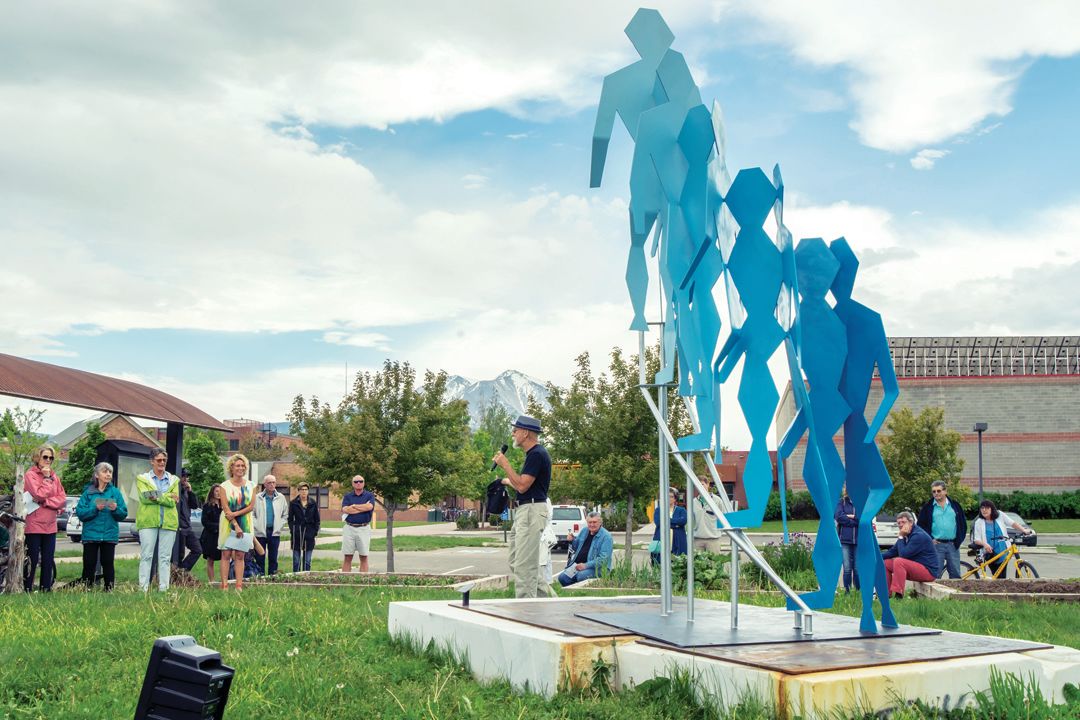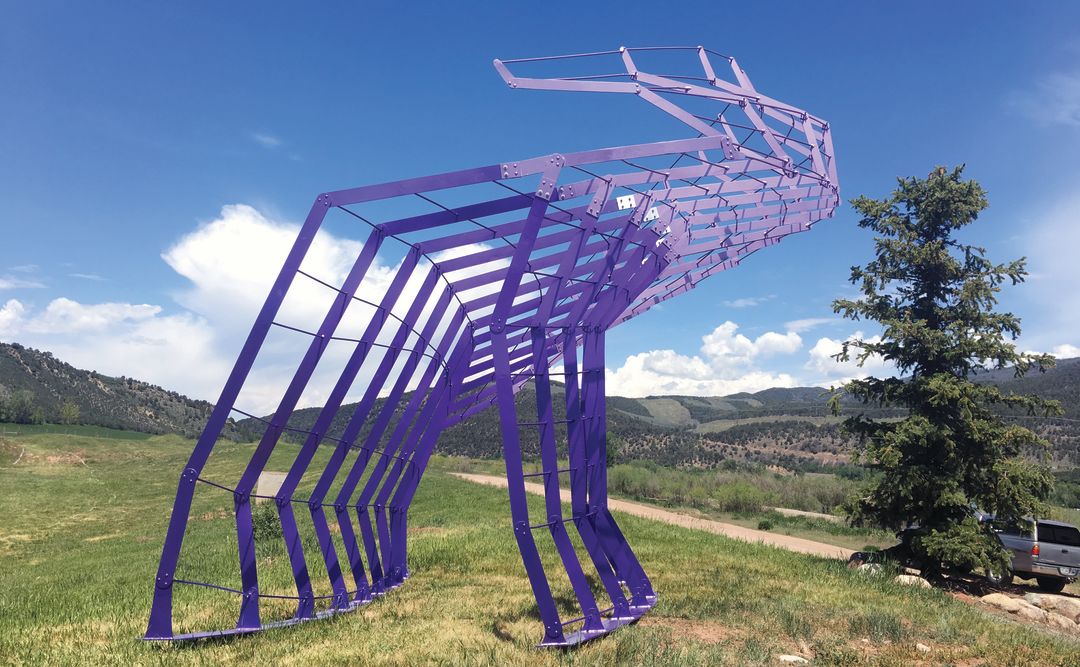Public Art Programs Give a Creative Cast Downvalley

Artist Joe Forrest Sackett discusses his piece, Dude Ascending, on Art Around Town's opening evening.
Image: Craig Turpin
Carbondale
A particular blooming season has taken place in downtown Carbondale for the last decade and a half; during it, public art sculptures pop up like exotic flowers decorating the landscape. Made of marble, steel, cast iron, fiberglass, and limestone, these annual expressions of artistic vision accentuate the intersection between the natural environment, semi-urban setting, and human imagination.
Since 2003, the town’s Public Arts Commission (CPAC) has been promoting these sculptures on the streets through Art Around Town, a program meant to engage both locals and visitors in a creative experience. “It brings the community together in venues around town. They can talk about what they like and engage in artistic conversation,” says Cheryl Bumgarner, CPAC’s chair.
Every year, 15 pieces are chosen from a pool of entries—this year a hundred artists from around the country vied for the coveted spots. The current crop of sculptures is one-third homegrown, as five of the creators hail from the Roaring Fork Valley.
The works are strategically sited throughout Carbondale—along Main Street, by the roundabout, near the library, and in other niches—and remain in place for a year. New this year is Otocast, an app that lists all of the town’s public art, along with a map and a statement from each artist.
Over time, Carbondale has permanently acquired 28 of the pieces. Most were artist donations, although CPAC aims to buy one piece a year if it can raise the money or has enough in the 1 Percent for the Arts program, which allocates funds for public art within certain town capital improvement projects.
When viewed together during a walkabout in Carbondale, the current group of sculptures forms an eclectic garden of colors, forms, materials, shapes, and aesthetics. Individually, each one has a story. Some may be obvious, like Minneapolis-based Kimber Fiebiger’s whimsical, bronze Humpty Dumpty, which sits on a wall near the library. Space Shadow 5, by Robert Hickler of Lakewood was designed on a computer, then cut from steel in a way that gives the appearance of fine lace.
Others, like Old Snowmass artist Nancy Lovendahl’s Intercession 16, are more contemplative. Her piece progressively moves from roughly carved, triangular chunks of limestone to more chiseled stone to a finely carved, smooth pink marble heart on top. The sculpture is meant to represent a call and response that speaks to Lovendahl’s sense of place. “This piece is really about our hearts being transformed,” she says. “Most people know of intercession in a religious context, when someone prays for you on your behalf. I’m using the idea differently, so that this sculpture is now an intercession to work on our behalf. It reminds me of what a physical heart might look like in the moment of beating into the love of the world.”
The sculptures do not share a common theme, beyond the fact that the CPAC jury chose them. “We look at how it’s going to fit into the town, how it is aesthetically, and what value it has in our environment,” Bumgarner explains.
And simple things can matter. “We like to have some pieces that pop color,” says Heather Bryan, a CPAC board member. “We’re looking for something that catches people’s eyes and evokes some thought or emotion.”
Art Around Town isn’t the only public sculpture being celebrated in Carbondale. This past spring, construction began on the Rio Grande ArtWay, a collaboration between the Carbondale Creative District and the Roaring Fork Transportation Authority that will encompass a one-mile stretch of the Rio Grande Trail running through town. A Latino Folk Art Park and a Youth Art Park, both with gardens and interactive pieces, are among the planned features along the trail. It’s shaping up to be a bountiful crop of public art.

A section of Motio 2.0 by Denver artist Wynn Earl Buzzell, Jr. at Willits Town Center.
Basalt
Basalt is also home to a burgeoning public art scene, thanks to community input and the creation of the Basalt Public Arts Commission (BPAC). During public discussions focused on town planning, a consistent theme emerged: residents were looking for more art to heighten a sense of place.
In 2015, the town council passed an ordinance that dedicated funds for public sculpture. The inaugural exhibit debuted this June with a five-part aluminum sculpture, collectively titled Motio 2.0, by Denver artist Wynn Earl Buzzell, Jr. The pieces are the first in a three-part series of temporary art installations that will be displayed over the next six years.
Buzzell’s colorful work depicts his vision of 84 kinetic, abstract human figures. They had been positioned all together outside the Denver Art Museum during an exhibit last year, but BPAC was interested in displaying groups of them in various locations, reflecting the notion that while Basalt has various population centers, it is one town.
“We felt that Wynn’s art spoke to what creates community, which is individuals and groups of individuals, and it has that spiraling-out sense,” says BPAC chair Loren Wilder.
The five pieces that make up Motio 2.0 can be found at the Willits Town Center roundabout, the Emma pedestrian bridge, downtown Basalt’s River Park, the Rio Grande Trail near the high school, and at the east end of Two Rivers Road. They’ll be on display through summer 2019.













































